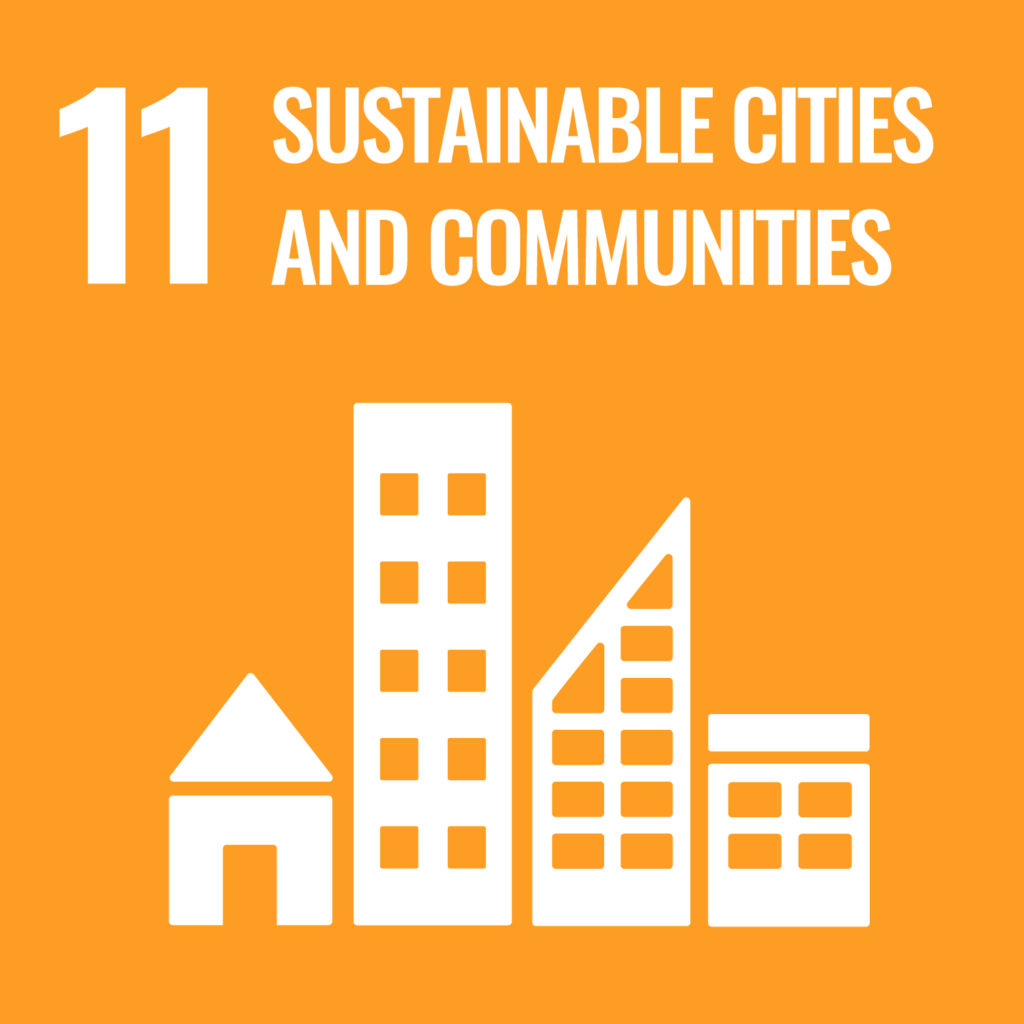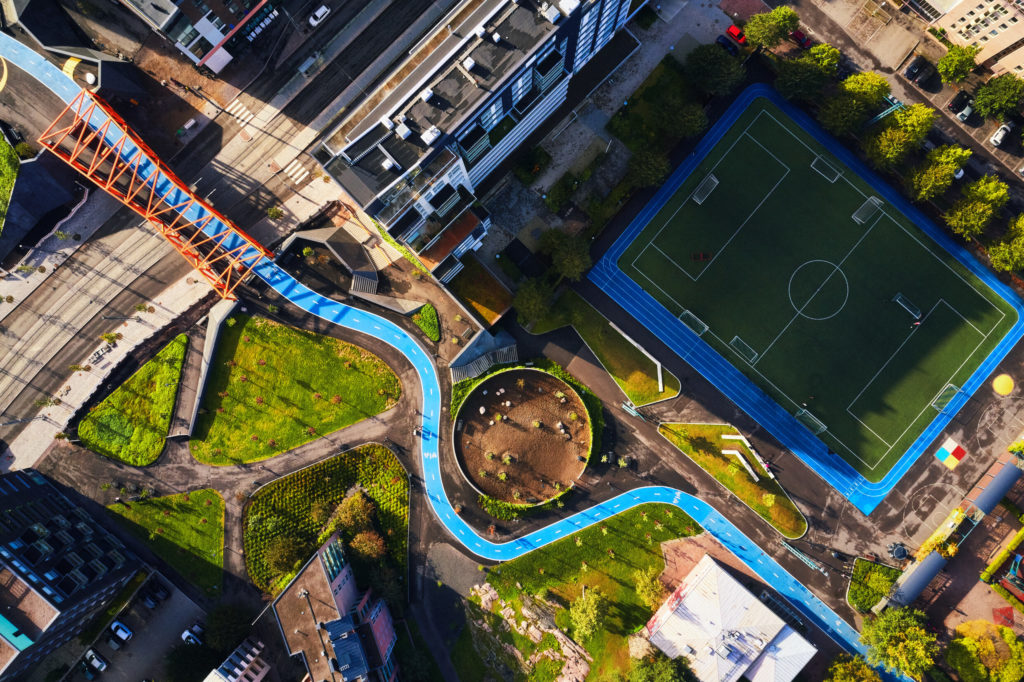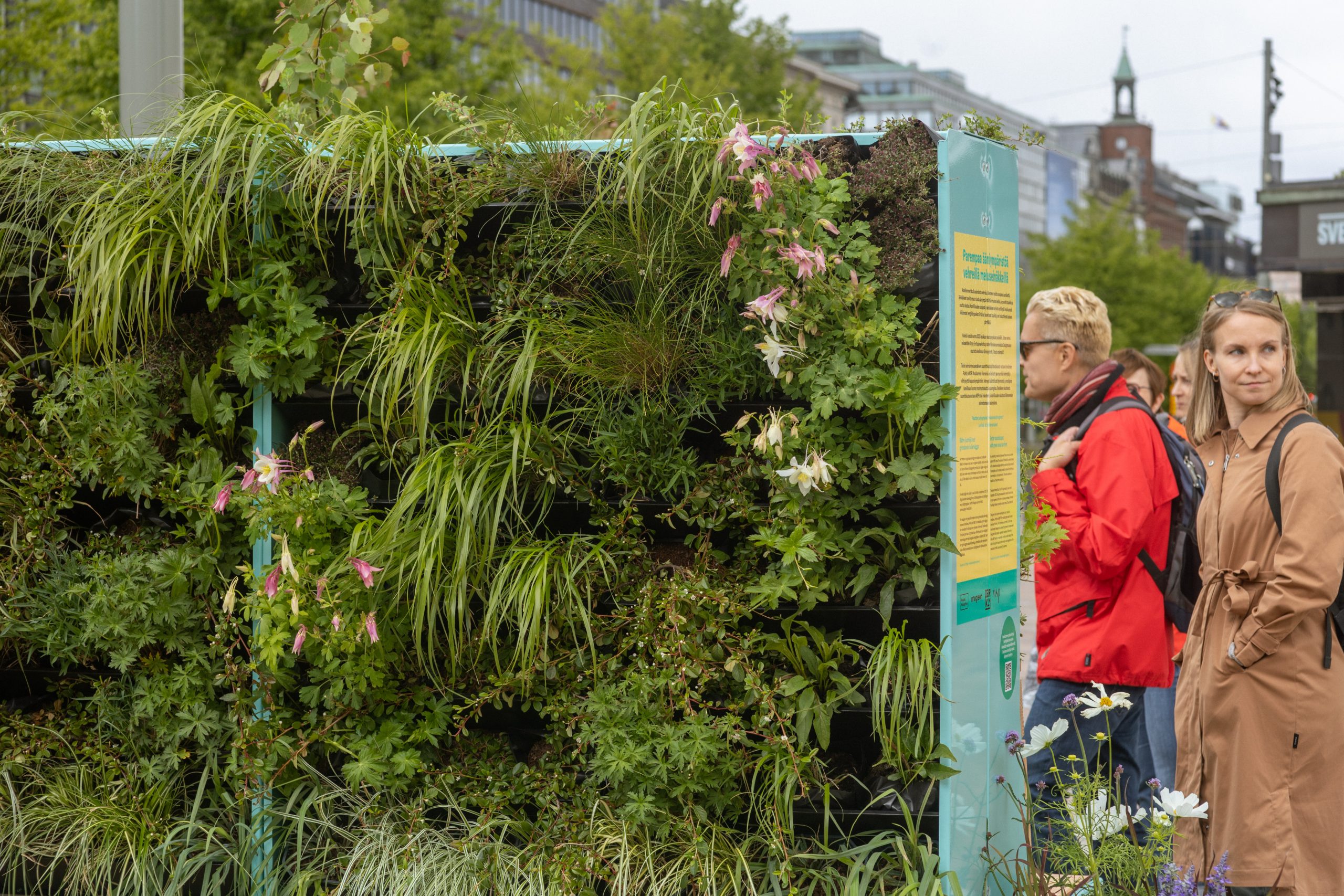

To achieve a sustainable urban structure, the key goals are SDG 11 Sustainable cities and communities and SDG 9 Industry, innovation and infrastructure. Other objectives, such as SDG 13 Climate action and SDG 15 Life on land, are also linked to the theme. In order to achieve these goals, Helsinki should focus even more on the challenges posed by the built environment to climate change mitigation and ecological diversity objectives. Another challenge for the built environment is adaptation to the changing climate.
However, it can be said that the urban structure of Helsinki is functional and the design and construction organisation is able to adapt to the challenges. The city is constantly being developed in a direction that takes sustainability objectives better into account in planning, design, construction and maintenance. However, the escalation of the climate crisis and loss of biodiversity is creating unprecedented pressure to learn new things, internalise knowledge and change practices. This is a critical factor in the achievement of the goals, as the required systemic change is extensive.
The key document guiding city planning in Helsinki is still the City Plan 2016, which guides the long-term development of the city structure with sights set on 2050. According to the City Plan, the urban structure is planned to rely more on public transport, while preserving the city’s key green and recreational values. The implementation of the City Plan in terms of time and the orientation of the city’s growth are guided through the City Plan implementation programme.
In 2024, the local master plan for Vartiosaari island was completed, in which the island was designated for green and recreational use, safeguarding its key ecological values. For the surroundings of Länsiväylä, the Lahdenväylä–Viikinranta area and Östersundom, the City continued its planning work at the level of the local master plan and the closely related impact assessment, especially with regard to identified sustainability aspects, such as nature and climate impacts. The aim of all ongoing local master plan work is to deliver an urban structure based on public transport, cycling and walking that will allow the city to grow in the longer term without creating unsustainable impacts on biodiversity and climate emissions.
In 2023, new detailed plans introduced a limit value for the lifecycle carbon footprint of a building, with the aim of steering building construction towards a lower carbon footprint. During the first phase, the limit value is set for new blocks of flats. As part of the impact assessment of detailed planning, a broader calculation of lifecycle climate emissions is also carried out using a methodology that is used for the most significant detailed plans. The results of the assessment are included in the plan material.
Functionality of infrastructure
As is usually the case in Finland, the functionality and reliability of Helsinki’s infrastructure are very good by global standards. Helsinki has good expertise in ensuring the functionality of infrastructure. As the changes in the operating environment intensify, structural sustainability faces more challenges. For example, climate change and extreme weather phenomena are increasing cost pressures on the maintenance of urban infrastructure. Temperatures fluctuating below and above zero and increased winter precipitation are already causing erosion and unforeseen, expensive repairs. On the other hand, the tightening budget allocates less and less money to the sustainable lifecycle management of infrastructure. Combined with the growth and densification of the built urban environment, this poses real challenges for ensuring quality and functionality.
For infrastructure, determining the repair backlog and sustainable lifecycle management of structures is challenging. It requires the compilation and management of extensive initial data, definition of the scope of the analysis and the performance of condition inspections. For bridges, a study has been carried out on lifecycle management that includes an assessment of the financing needs to maintain the current state of the bridges and eliminate the repair backlog. The method for calculating the repair backlog for green assets has been developed, and the calculation has been implemented. Green space and street asset management plans are being prepared to improve the situation, but it is not yet possible to form a sufficiently accurate picture of the growing infrastructure repair backlog.
Helsinki’s repair backlog of building assets is high compared to other Finnish cities, which is due to its relatively old building stock. The repair backlog of the real estate stock owned by Helsinki has fallen in real terms in recent years. Sales, demolitions, substitutive new construction and modernisation can further reduce the repair backlog.
Participation and interaction in urban planning
The dialogue between planners and residents on urban planning is guided by legislation, the City’s participation model and, in 2023–2025, the division’s participation plan and the available resources. There is no functional indicator for the effectiveness of interaction. The City considers it important that participants feel heard and perceive the planning process as fair. As part of the planning process, feedback from residents is addressed and decisions based on it are explained. Feedback from residents is part of the decision-making material.
The low participation of less active groups in urban planning is one of the biggest challenges in the interaction process. These groups include young people, less educated people, immigrants and residents of areas with a weaker social status, among others. In some city planning projects, specific measures are taken to involve less active groups, such as communicating in simplified language or conducting interviews or workshops. Greater and more frequent efforts should be made in this area.
There are many ways to take part in city planning. Many city residents want to participate online; there, we are also able to reach residents who lead busy lives and might not otherwise have the time to participate. We organise around 40 online surveys on city planning topics every year and hold a large number of online events.
In 2024, a transport climate panel was carried out, where a sample group of Helsinki residents discussed from their perspective how future transport will be smooth and fair for everyone: people living in different areas, people with different family situations, people using different modes of transport and people with different income levels. The panel discussed the challenging topic constructively, even though opinions were sometimes divided. In Helsinki, the use of different modes of transport in limited street space has strongly divided residents in discussions produced in other ways.
As regards traffic planning, Helsinki has allocated resources to sustainable traffic planning by e.g. investing in public transport, especially in the development of rail traffic, and cycling. Promoting cycling as a mode of transport improves and extensively develops the comfort and vitality of the city and the functionality of the transport system. It must be noted that Helsinki has also made transport infrastructure decisions that increase climate emissions from traffic and reduce local air quality, such as the decision to build the Sörnäinen tunnel. In the future, these types of projects must be viewed more critically from the point of view of overall sustainability.
Accessible Helsinki
The City of Helsinki has long carried out systematic work to improve accessibility. The City’s updated Accessibility Policies 2022–2025 were adopted by the City Board in 2022.
The City continuously strives to improve the accessibility of its services. Helsinki has made the results of its accessibility development work freely available to all. For example, the accessibility guidelines for outdoor areas have been introduced nationwide. The sujuva.info accessibility flashcards were perceived as good planning tools, especially due to their visual nature.
Commissioned by the Ministry of the Environment in 2024, the Universal Design in the Built Environment report describes in practical terms the principle of universal design in the planning and implementation of the built environment. The report looks at universal design in residential neighbourhoods, housing, and public spaces and environments. The report presents concrete approaches, solutions and example sites. The City of Helsinki has clear processes that guide building projects to take accessibility into account.
The Esteettömyyden perusteet (Basics of Accessibility) online course, published in 2024, has been completed by 67 people. The Facilities Services of the Social Services, Health Care and Rescue Services Division classified the training as mandatory for all Facilities Services staff.
Reducing the carbon footprint of buildings
As part of the Carbon Neutral Helsinki work, several measures are being implemented to improve the energy efficiency of construction. City facilities and service buildings are designed and implemented with an E value of -30% of the national threshold value for the use class, while building modernisations are implemented in such a way that the E value is reduced to 34% of the building’s original E value. For residential blocks of flats, a carbon footprint limit was introduced in 2023, guiding construction towards a lower carbon footprint. For non-residential buildings, an energy class of -20% of the national standard for the type of building is required in detailed planning. The new Building Act will set carbon footprint limits for more building types.
In 2023, all infrastructure projects commissioned by the City switched to low-carbon concrete that meets the class GWP.85 requirements as defined by the Concrete Association of Finland. During the preconstruction of the former Malmi Airport area, different solutions have been tested, with the aim of achieving a 50% reduction in emissions compared to so-called normal construction. One of the most significant measures has been the move away from the use of lime cement as a binder for soil stabilisation, which has also been implemented in all other foundation construction by the City.
The City’s facilities and service buildings are constantly undergoing energy efficiency investments, and have also adopted energy management, which has shown good results in improving indoor air quality and energy efficiency. The aim is also to increase the use of low-emission materials in construction, and the most cost-effective ways to reduce emissions in the construction phase with these materials are being explored during 2024.
The energy advice service for housing companies has promoted energy efficiency and the uptake of renewable energy in existing private housing stock by providing free and impartial advice. As of 2021, the service has advised over 700 housing companies. In 2024, the service adopted a regional approach, focusing on promoting energy efficiency in areas where there are few projects but a high potential for energy efficiency.
Other key tools for the City to guide the planning of a carbon-neutral city include land-use planning, plot allocation conditions, land-use agreements and the use of existing City-owned building stock.
Environmental health contributes to comfort and well-being
Environmental health in Helsinki is at a good level by international standards. Water quality at beaches is good, but can sometimes deteriorate due to run-off from heavy rainfall or the impact of wildlife. Chemical-related health risks are low, and the quality of tap water in Helsinki is excellent.
The main environmental health challenges are air quality and noise. Litter is also a major problem that not only has a negative impact on the environment and human health, but also reduces the comfort and attractiveness of urban areas. It also puts a strain on the City’s finances, as the City’s clean-up costs amount to over EUR 10 million per year. In order to reduce litter, the City has prepared the Litter Control Action Plan 2022–2025, and 24% of the actions had been implemented by the end of 2023.
In Helsinki, there are also many challenges related to indoor air, including in the City’s service buildings. The problems with indoor air are caused by, among other things, the repair backlog and the risky structures of old buildings. Helsinki has drawn up an indoor air programme for the years 2018–2028 to help tackle indoor air problems.
The air quality and noise environment in Helsinki are primarily degraded by road traffic. These challenges will increase in the future, especially as the urban structure becomes denser and new housing is built along busy roads. Air pollution concentrations and the noise situation are influenced in particular by traffic volumes and driving speed.
A plan combining the City’s objectives and measures regarding air protection and noise abatement was adopted in spring 2024. The measures will reduce air pollution and high traffic noise, and their negative impacts on health and comfort.
The air quality in Helsinki has improved over the last few decades, and it is fairly good at an international level. However, street dust, emissions from fireplaces and traffic exhausts continue to cause harm to people’s health and comfort. The new guideline values of the World Health Organization (WHO), based on the latest health information, are also widely exceeded in Helsinki.
Nitrogen dioxide concentrations from transport have fallen over the strategy period, thanks to advances in vehicle technology and the electrification of transport, and this trend is expected to continue. As the city becomes more densely built, these concentrations may still rise at times on busy, chasm-like streets.
However, the focus on air protection has shifted towards tackling emissions from street dust and domestic wood burning in particular. They will also continue to be a challenge in the future. The EU’s binding limit values for air pollution will be significantly tightened in 2030 with the revised Ambient Air Quality Directive. Meeting the limit value for inhalable particulate matter in particular will be a challenge for Helsinki. In recent years, efforts to combat street dust have included improving street maintenance and promoting the use of friction tyres. However, new measures are needed and existing ones need to be stepped up.
Wood burning in fireplaces is a major source of fine particles and carcinogenic benzo(a)pyrene in residential areas with detached houses. One of the measures to reduce the harmful effects of domestic wood burning has been increased communications on clean wood burning methods, and this work will continue.
The most significant source of noise in Helsinki is road traffic, with around 39% of Helsinki residents living in areas affected by it. The proportion of people living in noisy areas has increased slightly over the last decade. In addition to road traffic, continuous noise is caused by tram and rail traffic, and temporary noise is caused by construction and events, among other things. Strong continuous noise is harmful to health and wellbeing. It also reduces the quality and comfort of the environment.
Helsinki has established a wide range of tools to improve the City’s sound environment. The most important are the tools used in land use and traffic planning. For example, in recent years, speed limits on streets have been reduced, cycling and walking conditions have been improved and bus services have been electrified.
The design of the sound environment in public areas can contribute to their comfort. In summer 2023, innovative green noise walls were successfully tested in two locations in the city centre. The green walls were used to create a pleasant, calm oasis in an environment where traffic noise is a nuisance.
In addition to reducing loud noise, it is important to protect the sound environment where it is good, peaceful and interesting. Quiet and peaceful areas are very important to city residents. There is a fair number of these kinds of revitalising environments, such as nature sites and parks, throughout the city. As the city becomes denser, it is important that residents have easy access to revitalising, quiet green spaces.
Successes:
- Air quality at measuring points in Helsinki has improved.
- Green noise walls pilot.
- Air pollution from traffic exhaust has decreased.
- The Planect tool, a refined version of the HAVA tool, was introduced to calculate the carbon footprint of detailed and local master plans and guide them towards a lower carbon footprint.
- Progress has been made in tackling indoor air problems, and reports on indoor air issues have decreased.
Areas for development:
- The electrification of transport will not eliminate street dust or noise emissions.
- Concentration of housing near busy traffic routes.
- Reconciling the growing city with the city-level climate goals will require very determined work in the future.
- We need to manage growth in such a way that we stay on target with our goals to strengthen biodiversity and ensure that the local environment is preserved in line with our objectives.
- The sustainable modal split of transport should be brought onto a more positive growth path, as the modal share of public transport has not reached its pre-pandemic level.
Programmes:
Helsinki City Plan 2016
Air Quality and Noise Abatement Plan (ILME) 2024–2029 PDF, in Finnish


